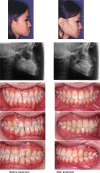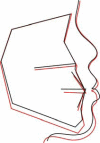Treatment in Borderline Class III Malocclusion: Orthodontic Camouflage (Extraction) Versus Orthognathic Surgery
- PMID: 19088881
- PMCID: PMC2581536
- DOI: 10.2174/1874210600802010038
Treatment in Borderline Class III Malocclusion: Orthodontic Camouflage (Extraction) Versus Orthognathic Surgery
Abstract
Aims: To investigate the differences in morphological characteristics of borderline class III patients who had undergone camouflage orthodontic treatment or orthognathic surgery, and to compare the treatment effects between these two modalities.
Materials and methods: Cephalograms of 25 patients (13 orthodontic, 12 surgical) with class III malocclusion were analyzed. All had a pretreatment ANB angle greater than -5 masculine.
Results: Using discriminant analysis, only Holdaway angle was selected to differentiate patients in the pretreatment stage. Seventy-two per cent patients were correctly classified. In the orthodontic group, reverse overjet was corrected by retraction of the lower incisors and downward and backward rotation of the mandible. The surgical group was corrected by setback of the lower anterior dentoalveolus and uprighting of the lower incisors. No difference was found in posttreatment soft tissue measurements between the two groups.
Conclusions: Twelve degree for the Holdaway angle can be a guideline in determining the treatment modalities for borderline class III patients, but the preferences of operators and patients are also important. (2) Both therapeutic options should highlight changes in the lower dentoalveolus and lower incisors. (3) Both treatment modalities can achieve satisfactory improvements to the people.
Keywords: Class III malocclusion; camouflage; orthognathic surgery.
Figures








References
-
- Graber TM, Vanarsdall RL, Vig KWL. Orthodontics . 4. St Louis: Mosby; 2005. Current Principles and Techniques ; p. 565.
-
- Fu M, Zhang D, Wang B, Deng Y, Wang F, Ye X. The prevalence of malocclusion in China--an investigation of 25392 children. Zhonghua Kou Qiang Yi Xue Za Zhi. 2002;37:371–373. - PubMed
-
- Chan GK. Class 3 malocclusion in Chinese (Cantonese) etiology and treatment. Am J Orthod Dentofacial Orthop. 1974;65:152–157. - PubMed
-
- Kerr WJ, Miller S, Dawber JE. Class III malocclusion surgery or orthodontics? Br J Orthod. 1992;19:21–24. - PubMed
-
- Stellzig-Eisenhauer A, Lux CJ, Schuster G. Treatment decision in adult patients with Class III malocclusion orthodontic therapy or orthognathic surgery? Am J Orthod Dentofacial Orthop. 2002;122:27–37. - PubMed
LinkOut - more resources
Full Text Sources
